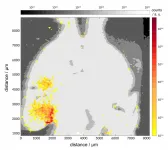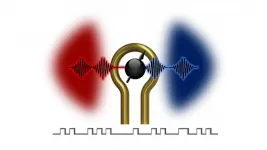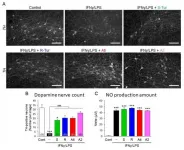(Press-News.org) The premise of heated tobacco (HT) is simple: tobacco leaf is heated, never burnt, so avoiding many harmful by-products of combustion for the user. The exhaled 'mist' is correctly termed an aerosol, which is almost invisible and far less dense and pungent than the exhaled smoke from combustible cigarettes.
Another advantage of HT is that there are no 'side-stream' emissions to impact air quality (or disturb bystanders - these emissions form part of the ambient smoke that's often known as environmental tobacco smoke (ETS) or 'second-hand' smoke), because unlike a combustible cigarette there is no constantly burning tip. Our previous research suggests that, unlike cigarettes, using our Pulze heated tobacco device causes no negative impact on indoor air quality (IAQ).
As the HT category grows in popularity as a potentially less harmful alternative to combustible cigarettes amongst adult smokers, there will likely be a desire for more information about how exhaled HT aerosol behaves around both users and bystanders. For these reasons we commissioned an independent research study undertaken by leading EU air quality researchers at the Kaunas University of Technology, Lithuania, to find out how our HT device Pulze's exhaled aerosol behaves in terms of spatial and temporal dynamics compared to combustible cigarette smoke.
The results, published in the peer-reviewed journal Aerosol and Air Quality Research, demonstrate:
Particles exhaled following use of the HT product are droplets comprised of 75-85% water and evaporate quickly, disappearing 10 seconds after a puff
By contrast, particles from conventional cigarettes are mainly non- or semi-volatile particles that are much more stable than those from HT: the removal of these particles takes much longer (30-45 minutes)
The average particle size was 93nm for HT and 165-200nm for CC
Distance between HT users and bystanders was shown to be the most significant factor affecting aerosol dynamics that influences short-term bystander exposure
While ventilation intensity and relative humidity didn't have statistically significant effects on aerosol particle behaviour, longer-term exposure should take into consideration both ventilation intensity and distance between HT users and bystanders
The aerosols exhaled following use of Pulze's 'standard' (345°C) and 'eco' (315°C) modes were both tested, but no significant difference in aerosol concentration and particle size distribution was recorded
Overall, the results demonstrate the exhaled aerosol produced using Pulze is very different in terms of chemical composition and spatial and temporal dynamics, and does not impact IAQ in the same way as cigarette smoke. This further validates the air quality and broader tobacco harm reduction credentials of the HT category compared to combustible cigarette smoke.
Testing, testing...
How was this research conducted? Study lead Professor Dainius Martuzevicius from the Department of Environmental Technology, Kaunas University of Technology, Lithuania, explains:
"To measure particle dynamics in controlled conditions, an indoor test chamber representing a standard room was used (see diagram), with 13m2 of floor area and a total volume of 35.8m3. A dummy bystander with a sampling inlet to replicate breathing was used to record the air and particle number concentration (PNC) and particle size distribution (PSD). These were measured by a Fast Mobility Particle Sizer (FMPS) spectrometer. Four-way mixing ventilation was chosen for this study because it is commonly used in residential buildings."
To conduct the experiments, either a Pulze HT device with accompanying tobacco consumable iD stick or combustible cigarettes were used by volunteers standing 0.5, 1m or 2m from the dummy bystander, with a total of 108 runs made to collate data.
The results showed that, as expected, the further the bystander was from the active user, the lower the detected PNC. If the user is closer to the bystander, then the exhaled aerosol does not have sufficient time to disperse into the surrounding air. As the distance increases, the exhaled aerosol can still be registered, but at much lower levels.
At 0.5m, the HT aerosol number concentration during puffs reached 1.6 million particles per cm3, compared to 147 million per cm3 for CC. After five seconds the puff concentration dropped to 1000-10,000 particles per cm3, which is comparable to the particle number concentrations in many urban environments.
At 1m and 2m the effect of a puff is significantly diminished because the aerosol is diluted and dispersed as it moves around the room. At 2m, only a very directional puff towards the bystander elevates the aerosol concentration.
HT and vaping have no negative impact on IAQ as measured using national and international IAQ guidelines. This is in contrast to combustible cigarettes, use of waterpipes, as well as many other indoor pollution sources, including incense burning and mosquito coils (see Table 2).
Dynamic changes
Science shows that HT indoor aerosol particle dynamics are fundamentally different from cigarette smoke. The HT exhaled aerosol is mostly composed of water droplets, and as such they do not linger as long in the air, and so do not exceed IAQ standards and guidelines, especially when compared to cigarette smoke.
This is positive news, and confirms findings by other researchers that have shown toxicant levels in exhaled HT aerosol are significantly lower than in cigarettes, with levels of some exhaled compounds indistinguishable from normal background levels, if detectable at all.
Overall, our scientific substantiation to date indicates that indoor Pulze use is unlikely to present an indoor air quality issue or risk to bystanders, especially compared to existing background levels of toxicants, indoor air quality standards and pollutants in urban areas.
"These results further confirm that use of HT products should be permitted in indoor spaces, but users should be courteous to those around them," adds Dr Grant O'Connell, Head of Tobacco Harm Reduction Science at Imperial Brands. "The findings also add to the body of evidence that heated tobacco products have an important part to play in making a meaningful contribution to tobacco harm reduction."
INFORMATION:
Read the full article here: https://aaqr.org/articles/aaqr-20-12-oa-0653
Paper also contains data about e-cigarette aerosol.
You are free to share this content with credit to Imperial Brands under a Attribution-NoDerivatives 4.0 International (CC BY-ND 4.0) license.
Researchers have found evidence for an anomalous phase of matter that was predicted to exist in the 1960s. Harnessing its properties could pave the way to new technologies able to share information without energy losses. These results are reported in the journal Science Advances.
While investigating a quantum material, the researchers from the University of Cambridge who led the study observed the presence of unexpectedly fast waves of energy rippling through the material when they exposed it to short and intense laser pulses. They were able to make these observations by using a microscopic speed camera that can track small and very fast movement on a scale that is challenging with many other techniques. This technique probes the material with two light pulses: the first one disturbs it ...
In lab tests, Imperial researchers have created a metal-based molecule that inhibits the build-up of a peptide associated with Alzheimer's disease.
A peptide is a fragment of a protein, and one of the key hallmarks of Alzheimer's disease is the build-up of a specific peptide known as amyloid-β. The team demonstrated that with the aid of ultrasound, their molecule can cross the blood-brain barrier in mice, targeting the part of the brain where the damaging peptide most often accumulates.
Alzheimer's disease is the most common form of dementia, affecting approximately 50 million people worldwide. There is a pressing need to develop drugs ...
Pioneering 'printed metal' procedure to create bespoke treatment for early knee osteoarthritis set to be trialled in the UK following MHRA approval.
World's first 3D printed high tibial osteotomy (HTO) device and procedure developed at University of Bath given approval for UK trials
Bespoke titanium alloy HTO implants that fit perfectly are designed to reduce discomfort for knee osteoarthritis patients
Sophisticated 3D scanning aims to make surgery quicker and safer
New TOKA process could make earlier intervention possible - saving patients decades of pain before surgery becomes viable
Intro
A ...
Many of us swing through gates every day -- points of entry and exit to a space like a garden, park or subway. Electronics have gates too. These control the flow of information from one place to another by means of an electrical signal. Unlike a garden gate, these gates require control of their opening and closing many times faster than the blink of an eye.
Scientists at the U.S. Department of Energy's (DOE) Argonne National Laboratory and the University of Chicago's Pritzker School of Molecular Engineering have devised a unique means of achieving effective gate operation with a form of information processing called electromagnonics. Their pivotal discovery allows real-time control of information transfer between microwave photons and magnons. And it could result in a new generation ...
An important new study by researchers at the U.S. Department of Energy's (DOE) Argonne National Laboratory has yielded critical fresh insights into the lithium production process and how it relates to long-term environmental sustainability, particularly in the area of transportation with batteries and electric vehicles.
The paper, "Energy, Greenhouse Gas, and Water Life Cycle Analysis of Lithium Carbonate and Lithium Hydroxide Monohydrate from Brine and Ore Resources and Their Use in Lithium Ion Battery Cathodes and Lithium Ion Batteries," in the journal ...
Prof. PAN Jianwei and Prof. ZHANG Jun from University of Science of Technology of China (USTC) of the Chinese Academy of Sciences, collaborating with Prof. CHU Tao's group from Zhejiang University, realized the fastest and miniaturized real-time quantum random number generator (QRNG) with the record-breaking output rate of 18.8 Gbps by combing a state-of-the-art photonic integrated chip with the optimized real-time post processing. The study was published in Applied Physics Letters on June 29.
Random number exists in many fields such as information security and cryptology industries. Different from other random number generators, QRNG, as the key part in quantum communication system, embraces the characteristics ...
Prof. DU Jiangfeng, Prof. RONG Xing, and their colleagues from the Key Laboratory of Micromagnetic Resonance, University of Science and Technology of China (USTC) of the Chinese Academy of Sciences (CAS), set the most stringent laboratory constraint on the exotic spin- and velocity-dependent interaction at the micrometer scale. This study was published in Physical Review Letters.
The search for dark matter, dark energy, and extra forces is important for the understanding of the existence of the matter that accounts for about a quarter of the universe, but little progress has been made. It is necessary to theoretically and experimentally find particles outside the Standard Model, a tradition ...
Shells of tamarind, a tropical fruit consumed worldwide, are discarded during food production. As they are bulky, tamarind shells take up a considerable amount of space in landfills where they are disposed as agricultural waste.
However, a team of international scientists led by Nanyang Technological University, Singapore (NTU Singapore) has found a way to deal with the problem. By processing the tamarind shells which are rich in carbon, the scientists converted the waste material into carbon nanosheets, which are a key component of supercapacitors - energy storage devices that are used in automobiles, buses, electric vehicles, trains, and elevators.
The study reflects ...
Osaka, Japan - When things get too much, we're often advised to "take a load off," but when it comes to bone maintenance, doing the opposite can be a good thing. Researchers from Japan have discovered some key mechanisms of how physical load stimulates bone growth.
In a study published July 13, 2021 at 11 a.m. ET in Cell Reports, researchers from the National Cerebral and Cardiovascular Center Research Institute have revealed that the expression of the peptide osteocrin (OSTN) is influenced by load - decreasing when load is reduced, and increasing when it is added.
Bones and skeletal muscles are strengthened by the load associated with exercise, preventing bone and muscle atrophy, and maintaining bone and muscle strength is important for maintaining physical activity. ...
Researchers from Kumamoto University, Japan have found that a component derived from turmeric essential oil, aromatic turmerone (ar-turmerone), and its derivatives act directly on dopaminergic nerves to create a neuroprotective effect on tissue cultures of a Parkinson's disease model. This appears to be due to enhanced cellular antioxidant potency from the activation of Nrf2. The researchers believe that the ar-turmerone derivatives identified in this study can be used as new therapeutic agents for Parkinson's disease.
Parkinson's disease is a neurodegenerative disease caused by the ...






